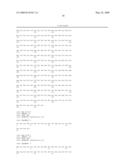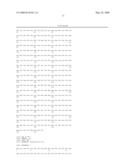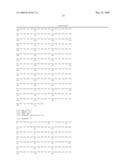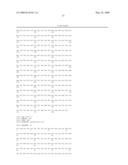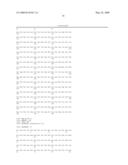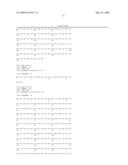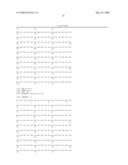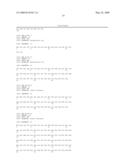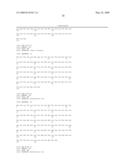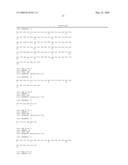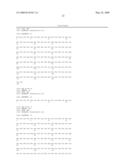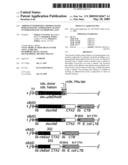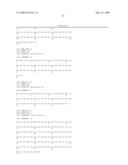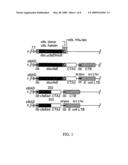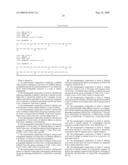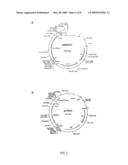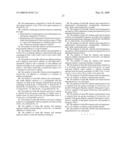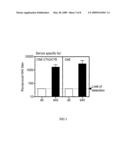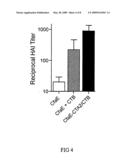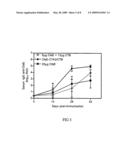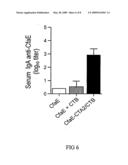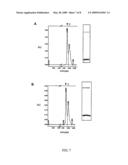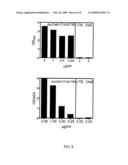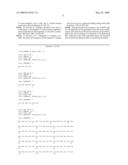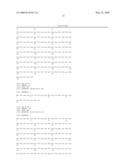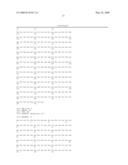Patent application title: Adhesin-enterotoxin chimera based immunongenic composition against enterotoxigenic Escherichia Coli
Inventors:
Stephen J. Savarino (Kensington, MD, US)
Randall K. Holmes (Golden, CO, US)
Michael G. Jobling (Aurora, CO, US)
IPC8 Class: AA61K948FI
USPC Class:
424463
Class name: Preparations characterized by special physical form capsules (e.g., of gelatin, of chocolate, etc.) coated capsules
Publication date: 2009-05-28
Patent application number: 20090136567
Claims:
1. An immunogenic composition comprising a purified fusion protein
containing Escherichia coli fimbrial adhesin polypeptide operatively
connected directly or via a linker and donor strand polypeptide sequence
to a toxin A subunit polypeptide.
2. The immunogenic composition of claim 1, wherein said adhesin polypeptide is linked to said toxin A subunit via said linker that is operatively linked at the C-terminus of said adhesin and wherein said linker is also operatively connected at its C-terminus to said donor strand that is operatively linked at its C-terminus to said toxin A subunit.
3. The immunogenic composition of claim 1, wherein said fusion protein is noncovalently linked to a toxin B subunit.
4. The immunogenic composition of claim 1, wherein said toxin A subunit is selected from the group consisting of cholera toxin A, cholera toxin A2 subunit, Escherichia coli heat-labile toxin A and Escherichia coli heat-labile toxin A2.
5. The immunogenic composition of claim 1, wherein said polypeptide of Escherichia coli fimbrial adhesin is derived from Class 5 fimbriae or CS3 fimbriae.
6. The immunogenic composition of claim 1, wherein said polypeptide of Escherichia coli fimbrial adhesin is derived from Escherichia coli fimbriae selected from the group consisting of colonization factor antigen 1, CS4, CS14, CS1, PCF071, CS17, CS19, CS2, and CS3.
7. The immunogenic composition of claim 1, wherein said polypeptide fragment of Escherichia coli fimbrial adhesin is a monomer or a polymer of adhesin polypeptides.
8. The immunogenic composition of claim 1, wherein said polypeptide fragment of Escherichia coli fimbrial adhesin is selected from the group consisting of CfaE, CsfD, CsuD, CooD, CosD, CsdD, CsbD, CotD and CstH.
9. The immunogenic composition of claim 1, wherein said linker is composed of the amino acid sequence selected from the group consisting of SEQ ID No. 1, SEQ ID No. 2 and SEQ ID No. 3.
10. The immunogenic composition of claim 1, wherein said donor strand has the amino acid sequence set forth in the sequence of SEQ ID No. 5.
11. The immunogenic composition of claim 1, wherein said donor strand is an 8 to 20 amino acid sequence from Escherichia coli fimbrial major subunit or adhesin monomer selected from the group consisting of CfaB, CsfA, CsuA1, CsuA2, CooA, CosA, CsbA, CsdA, CotA and CstH.
12. The immunogenic composition of claim 1, wherein said fusion protein contains a histinine tag operatively linked to the C-terminus of said linker and to the N-terminal end of said toxin.
13. The immunogenic composition of claim 1, wherein said conformationally stable adhesin construct is a polypeptide with the sequence set forth in the sequence selected from the group consisting of SEQ ID No. 6; SEQ ID No. 7; SEQ ID No. 9; SEQ ID No. 10; SEQ ID No. 11; SEQ ID No. 12; SEQ ID No. 13; SEQ ID No. 15; SEQ ID No. 16 and SEQ ID No. 30.
14. The immunogenic composition of claim 1, wherein said toxin A subunit consists of a polypeptide with the sequence set forth in SEQ ID No. 18 or SEQ ID No. 19.
15. The immunogenic composition of claim 3, wherein said fusion protein or said toxin B subunit is operatively connected at their N-terminal end to a signal sequence.
16. The immunogenic composition of claim 3, wherein said toxin B subunit is cholera toxin B or Escherichia coli heat-labile toxin B.
17. The immunogenic composition of claim 3, wherein said fusion protein and said toxin B subunit are expressed from a single expression vector.
18. The immunogenic composition of claim 3, wherein said toxin B subunit consists of a polypeptide sequence set forth in the sequence selected from the group consisting of SEQ ID No. 20; SEQ ID No. 21; SEQ ID No. 25 and SEQ ID No. 26.
19. The immunogenic composition of claim 15, wherein said signal sequence is the LTIIb toxin signal sequence of SEQ ID No. 24.
20. A method of inducing an immune response comprising the steps:a. administration of a priming dose of an immunogen comprising the composition of claim 1.b. administration of boosting doses with first dose at least 1 week after priming dose with a unit dose range of 50 μg to 1 mg of said immunogen in a buffered aqueous solution, wherein an immune response is elicited.
21. The method of claim 20, wherein said fusion protein is noncovalently linked to a toxin B subunit.
22. The method of claim 20, wherein said polypeptide of Escherichia coli fimbrial adhesin is selected from the group consisting of CfaE, CsfD, CsuD, CooD, CosD, CsdD, CsbD, CotD and CstH.
23. The method of claim 20, wherein said adhesin polypeptide is linked to said toxin A subunit via said linker that is operatively linked at the C-terminus of said adhesin and wherein said linker is also operatively connected at its C-terminus to said donor strand that is operatively linked at its C-terminus to said toxin A subunit.
24. The method of claim 20, wherein said polypeptide of Escherichia coli adhesin is a monomer or a polymer of adhesin polypeptides.
25. The method of claim 20, wherein said conformationally stable adhesin construct is a a polypeptide with the sequence set forth in the sequence selected from the group consisting of SEQ ID No. 6, SEQ ID No. 7; SEQ ID No. 9; SEQ ID No. 10: SEQ ID No. 11: SEQ ID No. 12; SEQ ID No. 13; SEQ ID No. 15; SEQ ID No. 16 and SEQ ID No. 30.
26. The method of claim 20, wherein said toxin A subunit is selected from the group consisting of cholera toxin A, cholera toxin A2 and Escherichia coli heat-labile toxin A, Escherichia coli heat-labile toxin A2.
27. The method of claim 20, wherein said toxin A subunit consists of a polypeptide with the sequence set forth in SEQ ID No. 18 or SEQ ID No. 19.
28. The method of claim 20, wherein said immune response inhibits enterotoxigenic Escherichia coli fimbriae adherence to human cells.
29. The method of claim 20, wherein said immune response reduces or prevents diarrhea in humans.
30. The method of claim 20, wherein said composition is administered subcutaneously, transdermally, intramuscularly, orally, transcutaneously or nasally.
31. The method of claim 20, wherein said immunogen is encoded in a DNA expression system and expressed in a live attenuated bacterial vector.
33. The method of claim 21, wherein said toxin B subunit consists of a polypeptide sequence set forth in the sequence selected from the group consisting of SEQ ID No. 20, SEQ ID No. 21; SEQ ID No. 25 and SEQ ID No. 26.
34. The method of claim 21, wherein said composition is administered subcutaneously, transdermally, intramuscularly, orally, transcutaneously or nasally.
35. The method of claim 21, wherein said immunogen is encoded in a DNA expression system and expressed in a live attenuated bacterial vector.
36. The method of claim 21, wherein said immune response inhibits enterotoxigenic Escherichia coli fimbriae adherence to human cells.
37. The method of claim 21, wherein said immune response reduces or prevents diarrhea in humans.
38. The method of claim 23, wherein said donor strand is an 8 to 20 amino acid sequence from Escherichia coli major structural fimbrial major subunit or adhesin monomer selected from the group consisting of CfaB, CsfA, CsuA1, CsuA2, CooA, CosA, CsbA, CsdA, CotA and CstH.
39. The method of claim 30, wherein said oral administration is via solution, or enteric coated granule capsule.
40. The method of claim 30, wherein said transcutaneous administration is via a dry patch.
41. The method of claim 31, wherein said bacterial vector is selected from the group consisting of Escherichia coli, member of the genus Shigella, member of the genus Camplylobacter, member of the genus Salmonella, and member of the genus Vibrio.
42. The method of claim 35, wherein said bacterial vector is selected from the group consisting of Escherichia coli, member of the genus Shigella, member of the genus Camplylobacter, member of the genus Salmonella, and member of the genus Vibrio.
43. The method of claim 39, wherein said oral administration is via solution, or enteric coated granule capsule.
44. The method of claim 39, wherein said transcutaneous administration is via a dry patch.
Description:
CROSS-REFERENCE TO RELATED APPLICATIONS
[0001]This application is a Continuation-in-part of application Ser. No. 11/340,003 filed Jan. 10, 2006 and also claims priority to provisional application 60/758,099 filed Jan. 11, 2006, the contents herein are incorporated by reference.
SEQUENCE LISTING
[0002]I hereby state that the information recorded in computer readable form is identical to the written sequence listing.
FIELD OF INVENTION
[0003]The inventive subject matter relates to a method of inducing an immune response against enterotoxigenic Escherichia coli using a proteinaceous chimera molecule composed of bacterial fimbriae components and immunogenic bacterial toxins. The inventive composition contemplates Escherichia coli adhesin molecularly fused to diarrheagenic bacteria toxin yielding an adhesin-toxoid chimera.
BACKGROUND OF INVENTION
[0004]Enterotoxigenic Escherichia coli (ETEC), one of several pathotypes of diarrheagenic E. coli, causes a secretory-type diarrhea ranging from mild to cholera-like purging. ETEC poses an important medical concern to persons living in and travelers visiting many developing countries. ETEC is a principal cause of diarrhea in young children in resource-limited countries and also travelers to these areas (Black, 1990; Huilan, et al, 1991). Among infants and young children, the organism is estimated to cause 210 million cases of diarrhea and 380,000 deaths annually (Qadri, et al, 2005).
[0005]ETEC produce disease by adherence to small intestinal epithelial cells and expression of a heat-labile (LTI) and/or heat-stable (ST) enterotoxin (Nataro, et al, 1990). ETEC typically attach to host cells via filamentous bacterial surface structures known as colonization factors (CFs). More than 20 different CFs have been described, a minority of which have been unequivocally incriminated in pathogenesis (Gaastra and Svennerholm, 1996).
[0006]Firm evidence for a pathogenic role exists for colonization factor antigen I (CFA/I), the first human-specific ETEC CF to be described. CFA/I is the archetype of a family of eight ETEC fimbriae that share genetic and biochemical features (Evans, et al, 1975; Gaastra and Svennerholm, 1996; Grewal, et al, 1997; Khalil, et al, 2000). This family includes coli surface antigen 1 (CS1), CS2, CS4, CS14, CS17, CS19 and putative colonization factor O71 (PCFO71). The complete DNA sequences of the gene clusters encoding all eight members of this fimbrial family have been published (Froehlich, et al, 1994; Froehlich, 1995; Jordi, et al, 1992; Perez-Casal, et al, 1990; Scott, et al, 1992). The four-gene bioassembly operons of CFA/I and related fimbriae are similarly organized, encoding (in order) a periplasmic chaperone, major fimbrial subunit, outer membrane usher protein, and minor fimbrial subunit. CFA/I assembly takes place through the alternate chaperone pathway, distinct from the classic chaperone-usher pathway of type I fimbrial formation and that of other filamentous structures such as type IV pili (Ramer, et al, 2002; Soto and Hultgren, 1999). Based on the primary sequence of the major fimbrial subunit, CFA/I and related fimbriae have been grouped as Class 5 fimbriae (Low, et al, 1996).
[0007]Studies of CS1 have yielded details on the composition and functional features of Class 5 fimbriae (Sakellaris and Scott, 1998). The CS1 fimbrial stalk consists of repeating CooA major subunits. The CooD minor subunit is allegedly localized to the fimbrial-tip, comprising an extremely small proportion of the fimbrial mass, and is required for initiation of fimbrial formation (Sakellaris, et al, 1999). Contrary to earlier evidence suggesting that the major subunit mediates binding (Buhler, et al, 1991), recent findings, therefore, have implicated the minor subunit as responsible for fimbria-mediated adhesion and identified specific amino acid residues required for in vitro adhesion of CS1 and CFA/I fimbriae (Sakellaris, et al, 1999). The major subunits are responsible for serological distinctiveness of each fimbrae with the minor subunits (Gaastra, et al, 2002).
[0008]Comparative evolutionary analyses of Class 5 major and minor subunits demonstrate that greater structural conservation exists among the minor subunits as compared to the major subunits. This is consistent with ability of anti-minor subunit but not anti-major subunit or fimbrial antibodies to inhibit mannose-resistant hemagglutination (MRHA) of ETEC that express heterologous, subclass-related fimbriae (Anantha, et al, 2004).
[0009]Prior research efforts in uropathogenic E. coli strains, containing Type 1 and P fimbriae, have been used as models to elucidate the mechanisms of assembly of pili on these strains of bacteria. These studies showed that assembly in uropathogenic E. coli is effected via a chaperone-usher pathway (Kuehn, et al, 1992; Sauer, et al, 1999; Choudhury, et al, 1999). An outcome of this work has been development of the principle of donor strand complementation, a process in which fimbrial subunits non-covalently interlock with adjoining subunits by iterative inter-subunit sharing of a critical, missing β-strand (Sauer, et al 1999; Choudhury, et al 1999; Barnhart, et al, 2000). Evidence has implicated this same mechanism in the folding and quaternary conformational integrity of Haemophilus influenzae hemagglutinating pili (Krasan, et al, 2000), and Yersinia pestis capsular protein, a non-fimbrial protein polymer (Zavialov, et al, 2002). Both of these structures are distant Class I relatives of Type 1 and P fimbriae that are assembled by the classical chaperone-usher pathway.
[0010]Despite the efforts in uropathogenic E. coli, the identity of the adhesion moieties and the mechanism of fimbriae assembly in ETEC have been unclear. That the fimbrial assembly and structural components of these distinct pathways share no sequence similarity suggests that they have arisen through convergent evolutionary paths. Nevertheless, computational analyses of the CFA/I structural subunits suggest the possibility that donor strand complementation may also govern chaperone-subunit and subunit-subunit interaction.
[0011]The eight ETEC Class 5 fimbriae clustered into three subclasses of three (CFA/I, CS4, and CS14), four (CS1, PCFO71, CS17 and CS19), and one (CS2) member(s) (referred to as subclasses 5a, 5b, and 5c, respectively) (Anantha, et al, 2004). Previous reports demonstrated that ETEC bearing CFA/I, CS2, CS4, CS14 and CS19 manifest adherence to cultured Caco-2 cells (Grewal, et al, 1997; Viboud, et al, 1996). However, conflicting data have been published regarding which of the component subunits of CFA/I and CS1 mediate adherence (Buhler, et al, 1991; Sakellaris, et al, 1999).
[0012]This question of which fimbrial components is responsible for mediating adherence was approached by assessing the adherence-inhibition activity of antibodies to intact CFA/I fimbriae, CfaB (major subunit), and to non-overlapping amino-terminal (residues 23-211) and carboxy-terminal (residues 212-360) halves of CfaE (minor subunit) in two different in vitro adherence models (Anantha, et al, 2004). It was demonstrated that the most important domain for CFA/I adherence resides in the amino-terminal half of the adhesin CfaE.
[0013]The studies briefly described above provide evidence that the minor subunits of CFA/I, as well as the homologous subunits of other Class 5 fimbriae, are the receptor binding moiety (Sakellaris, et al, 1999; Anantha, et al, 2004). Consistent with these observations, because of the low levels of sequence divergence of the minor subunits observed within fimbrial subclasses 5a and 5b (Sakellaris, et al, 1999), the evolutionary relationships correlated with cross-reactivity of antibodies against the amino-terminal half of minor subunits representing each of these two subclasses (Anantha, et al, 2004).
[0014]Similar, but distinct from Class 5 fimbriae, coli surface antigen (CS3) represents the common adhesive fibrillae of the ETEC colonization factor antigen II (CFA/II) complex. ETEC expressing these antigens are prevalent in many parts of the world. CS3 is composed of two subunits, CstH and CstG. Furthermore, anti-sera against CstH, but not CstG, exhibited hemagglutination inhibition, suggesting that the CstH was the CS3 adhesin.
[0015]The CS3 fibrillar assembly has been classified as a member of the classical chaperone-usher (CU) pathway based on the genetic relatedness of the CS3 periplasmic chaperone to the PapD superfamily (Hung, et al, 1999). Interestingly, it falls into the FGL (F1-G1 long) subfamily, referring to a characteristic structural feature of the chaperone, which mediates assembly of thin fibrillar or afimbrial adhesive organelles (Soto and Hultgren, 1996). Alignment of the N-terminal amino acid span of CstH with Yersinia pestis F1 capsule subunit reveals a common motif of alternating hydrophobic residues through amino acid 16 (with reference to the mature CstH polypeptide). This span of the F1 capsular subunit (Caf1) functions as the donor strand, interacting with the Caf1M chaperone and neighboring F1 protein subunits during capsular assembly and subunit articulation (Zavialov, et al, 2003). Therefore, it is logically reasoned that CstH may function in a similar manner.
[0016]Cholera toxin (CT) and E. coli enterotoxins (LTI and LTII) are members of the heat-labile enterotoxin family (Hirst, 1999; Holmes, 1997; Jobling and Holmes, 2005). They act on enterocytes of the small intestine and cause secretory diarrhea. Each toxin consists of a single A polypeptide and five identical B polypeptides all attached by noncovalent interactions. The known variants of CT and LTI belong to serogroup I and variants of LTII to serogroup II.
[0017]Structures of CT, LTI and LTIIb show that all have closely related folding patterns, despite differences in amino acid sequences between the B polypeptides of toxins in serogroups I and II (Domenighini, et al, 1995). The five identical B polypeptides form a doughnut-shaped module. The A polypeptide has an A1 domain located next to the upper face of the B subunit and an A2 domain that penetrates the central pore of the B pentamer. A1 and A2 are joined by a short surface-exposed loop. Proteolytic cleavage within that loop generates nicked holotoxin, with fragments A1 and A2 remaining linked by a disulfide bond. Five identical binding sites on the lower face of the B pentamer interact with specific receptors on target cells. The receptor-binding specificities among the enterotoxins differ greatly. CT and LTI bind tightly to ganglioside GM1. LTI, but not CT, binds to asialoganglioside GM1 and certain glycoproteins, and LTIIa and LTIIb bind best to gangliosides GD1b and GD1a, respectively.
[0018]The activity of enterotoxins on cells, such as epithelial cells upon colonization by ETEC, is mediated by an intricate sequence of events (Hirst, 1999; Holmes, 1997; Jobling and Holmes, 2005; Spangler, 1992). Upon colonization, ETEC heat-stable (ST) and/or heat-labile (LTI) enterotoxin act upon epithelial cells. In addition to LTI, ETEC heat-stable enterotoxin (ST) is a nonimmunogenic peptide analog of the intestinal peptide guanylin that activates intestinal membrane-bound guanylate cyclase (Schulz, et al, 1997).
[0019]Seroepidemiologic studies of young children has shown an inverse correlation between serum anti-CFA/I IgG antibody levels and a risk of disease with CFA/1-ETEC (Rao, et al, 2005). However, studies have failed to demonstrate that anti-LTI antibodies are protective. Evidence exists that administration of the B subunit of CT (CT-B) confers significant protection against ETEC caused diarrhea, which express the antigenically similar LTI enterotoxin (Clemens, et al, 1988; Peltola, et al, 1991). Furthermore, animal challenge studies have suggested that anti-fimbrial and anti-LTI antibodies act synergistically to protect against ETEC challenge (Ahren and Svennerholm, 1982).
[0020]Because of the promising immune responses to CFA/I and other coli surface antigens with nontoxic forms of LTI or CT, these antigens have been the focus of mucosal vaccine formulations against ETEC (Holmgren and Czerkinsky, 2005). An oral, killed whole-cell ETEC vaccine co-administered with CT-B has been extensively tested (Savarino, et al, 1999; Svennerholm, et al, 1997). Although the vaccine was found to be safe, it was not efficacious in infants (Savarino, et al, 2003). Furthermore, live attenuated ETEC vaccines have not proven effective partly due to the lack of achieving a proper balance between attenuation and immunogenicity (Altboum, et al, 2003; Barry, et al, 2003; Levine, et al, 1984; Turner, et al, 2001). Therefore, the importance of identification of the fimbrial component that might more effectively induce anti-adhesive immunity has become ever more acute. In ETEC, this moiety has been shown to be the minor fimbrial subunits, such as CfaE. Therefore, an aspect of this invention is the construction and use of conformationally stable ETEC fimbrial adhesins or adhesin domains in conjunction with components of bacterial toxoids, such as CT or LT, to induce immunity against diarreheagenic ETEC.
SUMMARY OF THE INVENTION
[0021]Enterotoxigenic Escherichia coli (ETEC) are one of several important pathotypes of E. coli and one of the most important of the diarrheagenic E. coli strains. The organisms cause a secretory-type diarrhea ranging from mild to cholera-like purging. Currently, no efficacious vaccine exists against ETEC. Therefore, new vaccine formulations against these organisms are critical, especially for developing countries where diarrheal diseases are most prevalent and medical infrastructure is limited.
[0022]An object of the invention is a composition comprising a conformationally-stable and protease resistant adhesin polypeptide-toxin fusion constructs for use in vaccine formulations. The contemplated fusion construct contains any bacterial toxin A subunit. Additionally, a contemplated version contains the A subunit, contained in the fusion product, in noncovalent association with a toxin B subunit of the same or different toxin. The composition is useful for the induction of an immune response against Escherichia coli. Examples of toxins include cholera toxin and enterotoxigenic Escherichia coli heat-labile enterotoxin.
[0023]A further object of the invention is a conformationally-stable and protease resistant adhesin polypeptide-bacterial toxin A subunit fusion construct, with or without noncovalent association with a toxin B subunit, wherein the toxin A an B subunits are derived from cholera toxin or E. coli heat-labile toxin.
[0024]A still further object of the invention is a method of inducing an immune response against Escherichia coli fimbriae or Escherichia coli, including Class 5 E. coli and E. coli CS3 fibrillae, by administration of a chimeric molecule or mixture of chimeric molecules, each composed of a stabilized ETEC adhesin polypeptide genetically fused to component of a bacterial toxoid, such as from cholera or ETEC heat-labile toxin, that exhibits immunomodulatory and adjuvant effects.
[0025]An additional object is the prevention of colonization of Escherichia coli by inhibiting adherence of ETEC fimbriae or fibrillae to host cells.
[0026]A further, additional object is the induction of an antibody immune response against enterotoxin by the by administration of a chimeric molecule or mixture of chimeric molecules, each composed of a stabilized ETEC adhesin polypeptide genetically fused to component of a bacterial toxoid, such as from cholera or ETEC heat-labile toxin.
[0027]These and other objects of the invention are accomplished by employing Escherichia coli adhesin polypeptides as a vaccine component to induce immunity.
BRIEF DESCRIPTION OF THE DRAWINGS
[0028]FIG. 1. Maps of plasmid inserts that encode the adhesin-entertoxoid chimeras. (A) T7-based clone from which the dscCfaE gene was amplified in the construction of plasmid inserts B and C. (B) pBAD-based clone for dscCfaE-CTA2/CTB5 chimera expression. (C) pBAD-based clone for dscCfaE-CTA2/LTB5 chimera expression. (D) and (E) show the planned inserts for expression of chimera proteins in which the CfaE adhesin domain (CfaEad) constitutes the adhesin component.
[0029]FIG. 2. Maps of two chimera expression plasmids. (A) Plasmid p0809C3 was constructed and used for production of the dscCfaE-CTA2/CTB5 chimera, and (B) p1121C1 was constructed and used for production of the dscCfaE-CTA2/LTB5 chimera. Each features a p15A origin of replication, chloramphenicol resistance marker (cat), and an arabinose-inducible promoter (pBAD) upstream of the tandem genes encoding eh adhesin-CTA2 fusion and B-enterotoxoid.
[0030]FIG. 3. Inhibition of CFA/I ETEC-induced MRHA.
[0031]FIG. 4. Murine serum IgG responses to CfaE after immunization with CfaE-CTA2/CTB chimera.
[0032]FIG. 5. Mouse serum IgG response to CfaE after intranasal immunization with CfaE-CTA2/CTB chimera.
[0033]FIG. 6. Mouse serum IgA responses to CfaE after intranasal immunization with CfaE, an admixture of CfaE plus CTB or CfaE-CTA2/CTB.
[0034]FIG. 7. Two-step purification of CfaE-CTA/CTB chimera by Talon chromatography followed by gel filtration.
[0035]FIG. 8. Binding of chimera to immobilized GM1.
DETAILED DESCRIPTION OF PREFERRED EMBODIMENTS
Design and Construction of Adhesin-Toxin Chimeras
[0036]The present invention relates to methods and a biological composition for the induction of anti-adhesive immune responses by the administration of conformationally stable, and thus immunologically active, adhesin polypeptide. Adhesins contemplated in the inventive composition include, but are not limited to, those from Class 5 fimbriae and from CS 3 (i.e., CstH). Adhesin, the distal molecular component of enterotoxigenic Escherichia coli fimbriae and fibrillae, are the likely effectors for bacterial attachment to host cells (Anantha, et al, 2004). Therefore, adhesins are critical for bacterial colonization and pathogenicity.
[0037]Polypeptide sequences from a number of pathogenic bacterial species, such as LT or CT, have been shown to be potent immunomodulators. Furthermore, CT B-subunit (CTB) confers significant protection against ETEC caused diarrhea (Clemens, et al, 1988; Peltola, et al, 1991). Consequently, concomitant administration of adhesin with bacterial toxin may provide greater protective immunity against diarrheagenic bacteria than formulations containing other ETEC moieties. The current invention provides a composition and method of using said composition for the induction of immunity, principally immunoglobulin-mediated, that specifically binds to bacterial adhesin to disrupt colonization of diarrheagenic bacteria by inhibiting activity of the bacterial adhesin and decreases the contribution of heat-labile entertoxins to diarrhea both by inhibiting activity of heat-labile enterotoxin and as a secondary effect of preventing bacterial colonization and thereby decreasing production of both heat-labile and heat-stable enterotoxins, in vivo.
[0038]Conformational stability, and potentially protease resistance of adhesin polypeptides is important to ensure maximum immunogenicity. Conformational integrity of adhesin monomers is conferred by a donated β-strand provided by an adjacent subunit. In Class 5 fimbriae, for example, conformational stability of the CFA/I adhesin, CfaE, is provided by the donor β-strand from CfaB. In CS3, stability can also be provided by peptide donor strands from adjacent monomers. In this regard, CstH donor strand provides stability to adjacent CstH adhesin monomers.
[0039]An aspect of the invention is a chimeric molecule with conferred conformational stability of an adhesin polypeptide in juxtaposition with bacterial toxins subunits, such as from LT or CT. In order to ensure conformational stability of adhesin polypeptide immunogens, with concomitant improved efficacy of vaccines, an aspect of this invention is polypeptide constructs designed to operatively provide a donor β-strand to adjacent adhesin polypeptide sequences that are operatively fused to toxin protein or polypeptide. The adhesin component of the constructs are composed of adhesin polypeptides linked at the C-terminal end to a linker polypeptide, which is in turn linked, at the C-terminal end, to a donor strand polypeptide. Donor strand can be provided by a number of sources including all or a portion of a major fimbrial structural subunit, such as CfaB. The adhesin component is then genetically fused to a polypeptide derived from a bacterial toxin A subunit. The inventive chimera can also be expressed in conjunction with the toxin B subunit, such that the expressed chimera containing the toxin A subunit component then assemble with the toxin B subunits to form a chimeric enterotoxin-like molecule.
[0040]The inventive composition contemplates a composition that is composed of any adhesin polypeptide, such as CfaE, CsfD, CsuD, CooD, CosD, CsdD, CsbD, CotD and CstH. The adhesin is then fused at the C-terminal end of adhesin to a donor strand via a linker polypeptide. The donor strand can come from any number of sources including major fimbrial subunits such as CfaB, CsfA, CsuA1, CsuA2, CooA, CosA, CsbA, CsdA, CotA and CstH. Such conformationally stabilized adhesin are herein described with the prefix "dsc." The inventive composition further contemplates that the conformationally stabilized adhesin is in-turn fused with a bacterial toxin A subunit, as illustrated in FIG. 1. An additional extension of the inventive composition contemplates the use of only the N-terminal domain of the native adhesin structure as the stable adhesin component of the inventive composition. Such conformationally stable adhesin domains are herein described with the suffix "ad", and without the prefix "dsc."
[0041]Examples of conformationally stabilized adhesin include, but are not limited to, dscCfaE (SEQ ID No. 6); dscCsbD (SEQ ID No. 12); dscCotD (SEQ ID No. 15), which contain a donor strand from CfaB, CotB and CotD, respectively. Additionally, non-Class 5 fimbrae adhesins can be used, such as Cst H by fusing the leader sequence (SEQ ID No. 27 to the N-terminal region of CstH (SEQ ID No. 28) and fusing this, via a linker (SEQ ID No. 1), to a donor strand from CstH (SEQ ID No. 29). The stable, dscCstH, sequence is illustrated in SEQ ID No. 30.
[0042]The conformationally stable adhesin is then fused to a full-length or truncated A2 bacterial toxin A subunit. The inventive composition contemplates that any of a number of bacterial toxin A subunits can be used. Examples of A subunits include, but are not limited to LTA2 (SEQ ID No. 18) and CTA2 (SEQ ID No. 19). Additionally, the inventive composition contemplates the ability to coordinately and concomitantly express the stabilized adhesin-toxin A subunit chimera with a toxin B subunit, either under a single operon, as illustrated in FIG. 2 or as gene products expressed from separate promoters either on a single plasmid or on separate but compatible plasmids, such that the adhesin-toxin A subunit and B subunits can spontaneously molecularly interact and assemble into an toxin-like molecule. The A and B subunits can be from the same or different bacterial species. Examples of toxin B subunits include, but are not limited to CTB (SEQ ID No. 21) and LTB (SEQ ID No. 23). The B subunit can contain an LTIIb leader sequence (SEQ ID No. 24) for improved expression as in SEQ ID No. 20 and SEQ ID No. 22, for CTB and LTB, respectively. Furthermore, the N-terminal five (5) amino acids of either CTA2 or LTA2 can be substituted for the amino acid sequences of SEQ ID Nos. 25 and 26. Table 1 summarizes the sequences.
TABLE-US-00001 TABLE 1 SEQ ID number Description 1-3 Linkers 4 CfaE 5 CfaB donor strand 6 dscCfaE 7 CfaEad 8 Signal sequence of dscCfaE (LTIIb) 9 dscCfaE (with aa subst from K to N) 10 dscCfaE (with aa subst from K to S) 11 dscCfaE (with aa subst from K to T) 12 dscCsbD 13 CsbDad 14 Signal sequence for CsbD (LTIIb) 15 dscCotD 16 CotDad 17 Signal sequence for CotD (LTIIb) 18 LTIA2 polypeptide 19 CTA2 polypeptide 20 CTB polypeptide with leader 21 CTB polypeptide with no leader 22 LTIB polypeptide with leader 23 LTIB polypeptide with no leader 24 LTIIb signal sequence 25 Variant 1 of N-terminal region of LTIA2 or CTA2 26 Variant 2 of N-terminal region of LTIA2 or CTA2 27 CstH signal peptide 28 CstH 29 CstH donor strand 30 dscCstH 31 LTIA2-variant 32 LTIA2-C199S 33 CTB El tor 34 CTA2 trucated 35 LTIA2 Truncated
Example 1
Construction of dscCfaE-CT and LT Chimeras
[0043]In order to more fully illustrate the invention, an example of an anti-ETEC composition containing CfaE, the minor subunit of CFA/I, is described. Referring to FIG. 1 (A), a conformationally stable CfaE was constructed by genetically joining a hairpin linker to the 3' end of the coding sequence of CfaE. The amino acid sequence of the linkers is described by SEQ ID No. 1, 2 and 3. An amino acid donor strand from CfaB, described in SEQ ID No. 4, was then joined at the 3' end of the linker and finally a hexahistidine tag was joined at the 3' end of the CfaB donor strand. The construct was then inserted in pET24 plasmids and expressed in E. coli bacteria. The resultant polypeptide, referred to as dscCfaE, was purified by nickel or cobalt affinity and cation-exchange chromatography. The recombinant polypeptide was soluable and stable. Based on gel filtration, the dscCfaE polypeptide existed as a monomer and CD spectroscopic analysis yielded results consistent with the existence of a predominantly β-stranded molecule.
[0044]Referring to FIG. 1, the A2 fragment of the cholera toxin A subunit was genetically fused to the carboxyl-terminus (C-terminus) dscCfaE. It should be noted, however, that instead of the A2 fragment of CTA, the A2 fragment, from the A subunit of other toxins can be used, such as LT-I. In order to facilitate purification of the monomeric dscCfaE, a Histidine (His-6) tail was added to the C-terminus of dscCfaE. See FIG. 1A). However, in order to facilitate purification of chimera with minimal modification of native sequence, in other constructs, His was substituted at selected sites within the toxin sequences of LT. However, because the pentameric B subunit of CT binds spontaneously to nickel or cobalt, either the CTB pentamer alone or an antigen construct that contains both a chimeric adhesin-CTA2 fusion polypeptide and the CTB pentamer can be purified directly by nickel or cobalt affinity chromatography without the need to add His-6 tag either to the adhesin-CTA2 fusion polypeptide or to the CTB polypeptide. Therefore, the coding region for the His-6 tag in dscCfaE was not included in the construct shown in FIG. 1B. Unlike pentameric CTB, the pentameric B subunit of LT-I does not bind spontaneously either to nickel or cobalt containing resins. However, introducing R13H and N94H substitutions into the sequence of the mature LT-1B polypeptide enables pentameric LT-1 B (or a corresponding antigen construct containing both a chimeric adhesin-CTA2 fusion polypeptide and the LT-IB pentamer) (the reader is referred to FIG. 1C) to bind to nickel or cobalt-containing resins and to be purified by nickel or cobalt affinity chromatography.
[0045]Furthermore, since the adhesin domain is stabilized by two intradomain disulfide bridges, placement of a stop codon after CfaE residue 199 to 204 results in production of a stable one-domain adhesin that lacks the pilus-forming domain of the original two-domain two-domain adhesin. Adhesin monomer with a stop codon introduced at this point contains the suffix "ad", for example CfaEad (SEQ ID. No. 7); CsbDad (SEQ ID. No. 13) and CotDad (SEQ ID No. 16). The coding sequence for the corresponding stable one-domain adhesin can therefore be used in place of the coding sequence for the stable two-domain dsc-adhesin variant to produce antigen constructs in which the adhesin-ad-CTA2 fusion polypeptide replaces the dsc-adhesin-CTA2 fusion polypeptide described above (see FIGS. 1D and 1E).
[0046]Referring to FIG. 1, when the coding regions for an adhesin-CTA2 fusion protein and a bacterial toxin B subunit are both present within an operon in the expression plasmid the adhesin-toxin A subunit chimera as well as a toxin B subunit are produced concomitantly. This permits both the expressed A and B toxin subunit polypeptides to be secreted into the periplasm of the E. coli host cell and to assemble spontaneously in the periplasm to form the desired chimeric enterotoxin-like antigen. The A and B subunits can be from the same or different bacterial species. As a further illustration, FIGS. 2A and 2B show a maps of a plasmids encoding a chimera constructs that contain the pentameric B subunits from CT and from LT-1, respectively.
[0047]FIG. 1 shows a dscCfaE-CTA2 fusion that is coordinately expressed with either the B subunit of cholera toxin or E. coli LT. The addition of LTIIB signal sequence enhances the likely expression of recombinant products since recombinant LTIIb is produced at a level of almost 100-fold over recombinant CT or CTB. In order to facilitate construction of CT-like chimeras, the expression vectors were modified by adding the coding region for CTA2 immediately downstream and in frame with the adhesin gene sequence so that the protein of interest is not only secreted into the periplasm but also contains the A2 polypeptide of CT at its C-terminus.
[0048]The coding sequence for dscCfaE was cloned in-frame into two vectors for expression of an A1 replacement antigen with an N-terminal LTIIb-B signal sequence and a C-terminal A2 fusion, upstream from the cholera toxin B subunit gene. The pLDR5 and pARLDR19 vectors place the modified cholera toxin operon under the control of a lac promoter or an arabinose-inducible pBAD promoter. (p0809C3), respectively. These clones were transformed into appropriate E. coli strains for expression. Both constructs produced chimera in the periplasm when grown in rich medium under inducing conditions.
[0049]After induction, cells were treated with polymyxin B to release periplasmic contents and the soluble fraction was purified by metal affinity chromatography (Dertzbaugh and Cox, 1998). Free CTB pentamer were separated from dscCfaE-CTA2/CTB chimera by gel filtration. Analysis of the chimera by SDS-PAGE and Western blot using antibodies specific for CTA, CTB and CfaE showed an anti-CTB-reactive band and a dscCfaE-CTA2 fusion protein band that reacted with both anti-CTA and anti-CfaE antisera. Referring to FIG. 8, using a 96-well ELISA format with GM1 coated plates and detection with a primary anti-CfaE antibody, we demonstrated that dscCfaE-CTA2/CTB chimeras indeed bound to GM 1.
[0050]As a further functional enhancement of expressed product, since the N-terminus of CTA2 occurs at residue 194, the sole cysteine-199 residue was changed in CTA2 to serine in order to prevent any aberrant disulfide bond formation between cysteine-199 and other cysteines in the antigen domain of the antigen-CTA2 fusion protein. Additionally, other vectors can be made, such as pARLDR19, for enhanced production of chimeras under the control of the arabinose-inducible pBAD promoter instead of the lac promoter (Tinker, et al, 2005; Li, et al, 2004).
Example 2
Functional Analysis of Chimera Constructs
[0051]The constructs were functionally examined. The construct in FIG. 1A or FIG. 1B was adsorbed onto 3 μm latex beads and added to human or bovine red cells with the resultant induction of MRHA. This observation provides clear evidence that CfaE is the adhesin in ETEC.
[0052]Crystallographic analysis of dscCfaE at 2.3 Å resolution revealed two elongate domains joined by a loop near its midpoint. Both the N-terminal and C-terminal domains form a β-sheet structure and the donor β-strand from CfaB fills a hydrophobic groove of the C-terminal domain stabilizing the molecule. The adhesin domain is stabilized by two intradomain disulfide bridges. Placement of a stop codon after CfaE residue 199 (refer to FIG. 1C) will yield a stable CfaE adhesion domain (designated CfaE-ad).
[0053]The antigenicity and immunogencity of dscCfaE were tested in animal models. Initially two rabbits were immunized parenterally with a four-dose (0, 28, 56 and 84 days) regimen of 250 μg per dose with Freund's adjuvant. Serum drawn 28 days after the last boost exhibited high anti-CfaE titers in each rabbit as measured by CfaE enzyme-linked immunosorbent assay (ELISA). Moreover, in a hemagglutination inhibition (HAI) assay, these antisera inhibited MRHA of ETEC that express CFA/I as well as CS4 and CS14 fimbriae.
[0054]A mouse experiment was conducted to determine the relative mucosal immunogenicity of dscCfaE in comparison to CFA/I fimbriae. Groups of 6 mice were given 25 μg of the test antigen either alone or co-administered with 1.5 μg of genetically detoxified LTR192 mucosal adjuvant, intranasally (IN). Another cohort of mice were immunized orogastrically at a dose of 250 μg with or without 10 μg of LTIR 192G. All animals received a 3-dose schedule at 2 week intervals. Robust titers were observed by ELISA when the immobilized antigen was homologous with the antigen used for immunization. In a head-to-head comparison of anti-adhesive antibody levels by the HAI assay, the dscCfaE immunized groups exhibited significantly higher titers of HAI antibody than the corresponding CFA/I immunized groups. Taken together, these animal studies suggest that CfaE is capable of inducing serum antibody responses upon parenteral or mucosal (IN) immunization. Furthermore, the antigen is superior to CFA/I in eliciting functional anti-adhesive antibodies.
[0055]Other murine immunization studies were conducted to evaluate the chimera's anitgenicity, specifically its capacity to induce an anti-adhesive antibody response and to evaluate the immunomodulatory properties of the dscCfaE-CTA2/CTB chimera upon IN immunization. In the antigenicity study, three groups of mice (n=3 per group) were immunized intraperitoneally (IP) with a two-dose regimen of dscCfaE-CTA2/CTB chimera, or dscCfaE alone or CTB alone at 0 and 28 days, with approximately 50 μg primary and 25 μg booster dose of the relevant antigen. Serum was collected pre-immunization and 12 days after the booster dose (day 40) and tested for in vitro inhibition of MRHA by incubation of a standard concentration of CFA/I-ETEC (strain H10407) with serial dilutions of antiserum before addition to human red cells and a determination of HAI activity. None of the preimmunization sera showed HAI activity at the minimum dilution tested (1:20) nor did post-immunization sera from CTB immunized mice. In contrast, serum from both the dscCfaE and dscCfaE-CTA2/CTB immunized groups inhibited MRHA at similar dilutions, as illustrated in FIG. 3. These corresponded to high serum anti-CfaE IgG titers as measured by ELISA at day 40 in both groups. The CfaE group geometric mean titer was 423,000 and the dscCfaE-CTA2/CTB group geometric mean titer was 233,000. Therefore, dscCfa-CTA2/CTB chimera effectively presents the adhesin for induction of functional antibody responses.
[0056]Referring to FIG. 4, five groups of mice (n=10 per group) were immunized IN at 0, 14, and 28 days with the following antigens: (1) dscCfaE-CTA2B (20 μg total weight calculated to give 8 μg CfaE and 11 μg CTB); (2) dscCfaE (8 μg)+CTB (13 μg) admixed; (3) dscCfaE alone (25 μg); (4) CTB alone (13 μg); and (5) PBS negative control. Serum IgG antibody titers to CfaE and CTB were determined by ELISA at 0, 14, 28 and 42 days. Mouse serum hemagglutination inhibition was examined subsequent to IN administration of CfaE chimeras. As illustrated in FIG. 4, like in FIG. 3, HAI titers were significantly higher than each of the other groups at day 42. Additionally, referring to FIG. 5, all groups receiving CTB in any form exhibited high serum anti-CTB titers by day 42, as expected. The dscCfaE-CTA2/CTB chimera group showed a significantly higher serum IgG anti-CfaE response than either the CfaE+CTB admixture or the dscCfaE groups measured at days 14, 28 and 42.
[0057]In addition to IgG, IgA titers were also examined following administration of dscCfaE-CTA2/CTB5. Anti-CfaE titers were measured by ELISA on day 0 and day 42 and are illustrated in FIG. 6. IgA titers at baseline (day 0) were below the limit of detection for all groups in FIG. 5. The result, as illustrated in FIG. 6, shows that the chimera group yielded a significantly higher titer of IgA than the other groups.
Example 3
Potential Use of Inventive Chimera in Vaccine Formulations
[0058]The adhesins are likely the most important component for the induction of immunity against diarrheagenic E. coli, although preventing the activity of the heat-labile enterotoxin may also contribute to protection. Because the fimbrial adhesins are inherently unstable and subject to degradation when devoid of their non-covalent linkage to adjacent subunits, the current invention significantly improves the immunogenic potential of adhesin by conferring conformational stability. Additionally, the immunogenic efficacy of conformationally stable adhesin is likely improved significantly by providing the adhesin construct as a chimera with enterotoxin components that have both potent immunogenicity and adjuvant activity.
[0059]The inventive construct is anticipated to be useful as a vaccine component for the induction of an immune response and/or anti-toxic immunity against diarrheagenic E. coli. The method for induction of immunity contains the following steps: [0060]a. priming by administration of immunogen comprising a chimeric polypeptide containing a conformationally stable two-domain or one-domain adhesin fused component fused to an intact or truncated A2 polypeptide derived from a toxin A subunit. The immunogen can also comprise the chimeric polypeptide, assembled into an enterotoxin-like chimera by noncovalent interactions between its intact or truncated A2 polypeptide with the toxin B subunit polypeptides. The toxin A and B subunits can be derived from any bacterial toxins, for example Vibrio cholerae or E. coli heat-labile enterotoxin. The range of a unit dose of immunogen is 50 μg to 1 mg, and can be administered either transcutaneously, such as via dry patches, transdermally, intramuscularly, orally in milk or other solutions, transcutaneously or nasally. [0061]b. Subsequent to a priming dose, 2 to 4 boosting doses are also administered by similar routes with a unit dose of 50 μg to 1 mg of immunogen.
[0062]An alternative vaccine approach is the administration of a DNA construct, capable of expressing the chimera polypeptides inserted into live attenuated bacterial vectors. Examples of potential vectors include, but are not limited to, members of the genus Vibrio including Vibrio cholerae, Escherichia coli, members of the genus Camplyobacter, members of the genus Salmonella, and members of the genus Shigella.
Example 4
DscCfaE-CTA-2/CTB Chimera Scale Up
[0063]In order to produce adequate quantities of adhesin/toxin chimera, the development of a production and purification regimen is disclosed. An example is presented of a preferred production and purification procedure, although other methods can be utilized that ultimately yield stable and immunogenic adhesin/toxin chimeric product.
[0064]In this example, the arabinose-inducible vector (p0809C3) was selected and used to transform the E. coli strain BL21, which is Lon and OmpT protease deficient. Starting with 30 g of cell paste, cells were broken using microfluidization. The soluble fraction was subjected to the two step process of Talon resin chromatography and gel filtration by FPLC. After loading and washing the Talon resin, the chimera fraction was eluted with 50 mM imidazole. Referring to FIG. 7, the eluted fractions under the peak were pooled, concentrated and subjected to gel filtration. The gel filtration elution showed a two-hump peak pattern with the two peaks corresponding to chimera (early peak) and a CTB pentamer (late peak) of similar heights. The pooled chimera fractions were analyzed by SDS polyacrylamide gel electrophoresis (PAGE) and Western blot analysis with anti-CTB, anti-CTA and anti-CfaE antiserum.
[0065]In order to confirm the functional integrity of the product, the product was tested for its ability to bind to ganglioside GM-1 as illustrated in FIG. 8. ELISA assay was conducted using GM1 immobilized in wells of microtiter plates. In the assay, dscCfaE-CTA2/CTB was exposed to the GM1 immobilized plates and the bound chimera visualized by anti-CfaE antisera. No anti-CfaE reactivity was observed in control experiments when CTB or dscCfaE was allowed to interact with immobilized GM1 in the microtiter plates before probing for bound CfaE antigen with anti-CfaE antiserum. In FIG. 8 a dose response was observed over a chimera concentration range of 0.25 to 2 μg/ml added to GM 1-containing wells. The yield of chimera using this procedure was on the order of 0.05 mg/g of starting cell paste.
REFERENCES
[0066]1. Ahren, C. M., and A. M. Svennerholm. 1982. Synergistic protective effect of antibodies against Escherichia coli enterotoxin and colonization factor antigens. Infect. Immun. 38:74-79. [0067]2. Altboum, Z., M. M. Levine, J. E. Galen, and E. M. Barry. 2003. Genetic characterization and immunogenicity of coli surface antigen 4 from enterotoxigenic Escherichia coli when it is expressed in a Shigella live-vector strain. Infect. Immun. 71:1352-1360. [0068]3. Anantha, Ravi P., A. L. McVeigh, L. H. Lee, M. K. Agnew, F. J. Cassels, D. A. Scott, T S. Whittam, and S. J. Savarino. 2004. Evolutionary and functional Relationships of colonization factor antigen I and other Class 5 adhesive fimbriae of enterotoxigenic Escherichia coli. Inf and Imm. 72: 7190-7201. [0069]4. Barnhart M M, Pinkner J S, Soto G E, et al. From the cover: PapD-like chaperones provide the missing information for folding of pilin proteins. Proc. Natl. Acad. Sci. U.S.A. 2000; 97:7709-14. [0070]5. Barry, E. M., Z. Altboum, G. Losonsky, and M. M. Levine. 2003. Immune responses elicited against multiple enterotoxigenic Escherichia coli fimbriae and mutant LT expressed in attenuated Shigella vaccine strains. Vaccine 17:333-340. [0071]6. Buhler, T., H. Hoschutzky, and K. Jann. 1991. Analysis of colonization factor antigen I, an adhesin of enterotoxigenic Escherichia coli O78:H11: fimbrial morphology and location of the receptor-binding site. Infect Immun 59:3876-3882. [0072]7. Black, R. E. 1990. Epidemiology of travelers' diarrhea and relative importance of various pathogens. Rev Infect Dis 12 (Suppl 1):S73-S79. [0073]8. Choudhury D, A. Thompson, V. Stojanoff, et al. X-ray structure of the FimC-FimH chaperone-adhesin complex from uropathogenic Escherichia coli. Science 1999; 285:1061-6. [0074]9. Clemens, J. D., D. A. Sack, J. R. Harris, J. Charkraborty, P. K. Neogy, B. Stanton, N. Huda, M. U. Khan, B. A. Kay, M. R. Khan, M. Anasaruzzaman, M. Yunus, M. R. Rao, A. M. Svennerholm, and J. Holmgren. 1988. Cross-protection by B subunit whole cell cholera vaccine against diarrhea associated with heat-labile toxin producing enterotoxigenic Escherichia coli results of a large-scale field trial. J. Infect. Dis. 158:372-377. [0075]10. Dertzbaugh, M. T., and L. M. Cox. 1998. The affinity of cholera toxin for Ni2+ ion. Protein Eng. 11:577-581. [0076]11. Domenighini, M., M. Pizza, M. G. Jobling, R. K. Holmes, and R. Rappuloli. 1995. Identification of errors among database sequence entries and comparison of correct amino acid sequences for the heat-labile enterotoxins of Escherichia coli and Vibrio cholerae. Mol Microbiol 15: 1165-1-167. [0077]11. Evans, D. G., R. P. Silver, D. J. Evans, Jr., D. G. Chase, and S. L. Gorbach. 1975. Plasmid-controlled colonization factor associated with virulence in Escherichia coli enterotoxigenic for humans. Infect Immun 12:656-667. [0078]12. Froehlich, B. J., A. Karakashian, L. R. Melsen, J. C. Wakefield, and J. R. Scott. 1994. CooC and CooD are required for assembly of CS1 pili. Mol Microbiol 12:387 401. [0079]13. Froehlich, B. J., A. Karakashian, H. Sakellaris, and J. R. Scott. 1995. Genes for CS2 pili of enterotoxigenic Escherichia coli and their interchangeability with those for CS1 pili. Infect Immun 63:4849-56. [0080]14. Gaastra, W., H. Sommerfelt, L. van Dijk, J. G. Kusters, A. M. Svennerholm, and H. M. Grewal. 2002. Antigenic variation within the subunit protein of members of the colonization factor antigen I group of fimbrial proteins in human enterotoxigenic Escherichia coli. Int J Med Microbiol 292:43-50. [0081]15. Gaastra, W., and A. M. Svennerholm. 1996. Colonization factors of human enterotoxigenic Escherichia coli (ETEC). Trends Microbiol 4:444-452. [0082]16. Grewal, H. M., H. Valvatne, M. K. Bhan, L. van Dijk, W. Gaastra, and H. Sommerfelt. 1997. A new putative fimbrial colonization factor, CS19, of human enterotoxigenic Escherichia coli. Infect Immun 65:507-513. [0083]17. Hirst,k T. R. 1999. Cholera toxin and Escherichia coli heat-labile enterotoxin, p. 104-129. In E. Alouf and J. H. Freer (ed.), The Comprehensive Sourcebook of Bacterial Protein Toxins, 2 ed, vol. 6. Academic Press, San Diego. [0084]18. Holmgren, J., and C. Czerkinsky. 2005. Muscosal immunity and vaccines. Nat. Med. 11:S45-53. [0085]19. Holmes, R. K. 1997. Heat-labile enterotoxins (Escherichia coli), p. 30-33. InR. Rappuloi and C. Montecucco (ed.), Guidebook to Protein Toxins and Their use in Cell Biology. Oxford University Press, New York. [0086]20. Huilan, S., L. G. Zhen, M. M. Mathan, M. M. Mathew, J. Olarte, R. Espejo, U. Khin Maung, M. A. Ghafoor, M. A. Khan, Z. Sami, and et al. 1991. Etiology of acute diarrhea among children in developing countries: a multicentre study in five countries. Bull World Health Organ 69:549-55. [0087]21. Hung, D. L., S. D. Knight, R. M. Woods, J. S. Pinkner and S. J. Hultgren. 1996. Molecular basis of two subfamilies of immunoglobulin-like chaperones. EMBO J. 15:3792-3805. [0088]22. Jobling, M. G., and R. K. Holmes. 2005. Activation of second messenger pathways by ADP-ribosylation of G-proteins, p. 9-46. In T. Proft (ed.), Microbial Toxins: Molecular and Cellular Biology. Horizon Bioscience, Wymondham, United Kingdom. [0089]19. Jordi, B. J. A. M., G. A. Willshaw, A. M. van der Zeijst, and W. Gaastra. 1992. The complete nucleotide sequence of region 1 of the CFA/I fimbrial operon of human enterotoxigenic Escherichia coli. DNA Seq 2:257-26. [0090]20. Khalil, S. B., F. J. Cassels, H. I. Shaheen, L. K. Pannell, K. A. Kamal, B. T. Pittner, M. Mansour, R. Frenck, S. J. Savarino, and P. L. F. 2000. Presented at the 100th General Meeting of the American Society for Microbiology, Los Angeles, Calif. [0091]21. Krasan G P, Sauer F G, Cutter D, et al. Evidence for donor strand complementation in the biogenesis of Haemophilus influenzae hemagglutinating pili. Mol. Microbiol. 2000; 35:1335-47. [0092]22. Kuehn M J, J. Heuser, S. Normark and S. J. Hultgren. 1992. P pili in uropathogenic E. coli are composite fibres with distinct fibrillar adhesive tips. Nature 356:252-5. [0093]23. Levine, M. M., R. E. Black, M. L. Clements, C. R. Young, C. P. Cheney, and P. Schad. 1984. Prevention of enterotoxigenic Escherichia coli diarrheal infection in man by vaccines that stimulate anti-adhesion (anti-pili) immunity, p223-244. In E. C. Boedeker (ed.), Attachement of Micro-organisms to the Gastrointestinal Mucosal Surface. CRC Press, Boca Raton. [0094]24. Li, X., J. L. Erbe, C. V. Lockatell, D. E. Johnson, M. G. Jobling, R. K. Holmes, and H. L. Mobley. 2004. Use of translational fusion of the MrpH fimrial adhesin-binding domain with the cholera toxin A2 domain, coexpressed with the cholera toxin B subunit, as an intranasal vaccine to prevent experimental urinary tract infection by Proteus mirabilis. Infect. Immun. 72:7306-7310. [0095]25. Low, D., B. Braaten, and M. Van der Woude. 1996. Fimbriae, p. 146-157. In F. C. Neidhardt, R. Curtiss III, J. L. Ingraham, E. C. C. Lin, K. B. Low, B. Magasanik, W. S. Reznikoff, M. Riley, M. Schaechter, and H. E. Umbarger (ed.), Escherichia coli and Salmonella: Cellular and Molecular Biology, 2nd ed, vol. Volume 1. ASM Press, Washington, D.C. [0096]26. Nataro, J. P., and J. B. Kaper. 1998. Diarrheagenic Escherichia coli. Clin Microbiol Rev 11: 142-201. [0097]27. Perez-Casal, J., J. S. Swartley, and J. R. Scott. 1990. Gene encoding the major subunit of CS1 pili of human enterotoxigenic Escherichia coli. Infect Immun 58:3594-3600. [0098]28. Peltola, H., A. Siitonen, H. Kyronseppa, I. Simula, L. Mattila, P. Oksanen, M. J. Kataja, and M. Cadoz. 1991. Prevention of traveller's diarrhea by oral B-subunit/whole-cell cholera vaccine. Lancet 338:1285-1289. [0099]29. Qadri, F., A. M. Svennerholm, A. S. Faruque, and R. B. Sack. 1005. Enterotoxigenic Escherichia coli in developing countries: Epidemiology, microbiology, clinical features, treatment, and prevention. Clin. Microbiol. Rev 18:465-483. [0100]30. Ramer, S. W., G. K. Schoolnik, C. Y. Wu, J. Hwang, S. A. Schmidt, and D. Bieber. 2002. The Type IV pilus assembly complex: Biogenic interactions among the bundle forming pilus proteins of enteropathogenic Escherichia coli. J Bacteriol 184:3457-65. [0101]31. Rao, M. R., T. F. Wierzba, S. J. Savarino, R. Abu-Elyazeed, N. El-Ghoreb, E. R. Hall, A. Naficy, I Abdel-Messih, R. W. Frenck, Jr., A. M. Svennerholm, and J. D. Clemens. 2005. Serologic correlates of protection against enterotoxigenic Escherichia coli diarrhea. J. Infect. Dis. 1991:562-570. [0102]32. Savarino, S. J., E. R. Hall, S. Bassily, F. M. Brown, F. Youssef, T. F. Wierzba, L. Peruski, N. A. El-Masry, M. Safwat, M. Rao, H. El Mohamady, R. Abu-elyazeed, A. Naficy, A. M. Svennerholm, M. Jertborn, Y. J. Lee, and J. D. Clemens. 1999. Oral, inactivated, whole cell enterotoxigenic Escherichia coli plus cholera toxin B subunit vaccine: results of the initial evaluation in children. PRIDE Study Group. J. Infect. Dis. 179:107-114. [0103]33. Savarino, S. J., R. Abu-Elyazeed, M. R. Rao, R. W. Frenck, I. Abdel-Messih, H. E. R., S. Putnam, H. El-Mohamady, T. Wierzba, B. Pittner, K. Kamal, P. Moyer, M. B. Z., A. M. Svennerholm, Y. J. Lee, and J. D. Clemens. 2003. Presented at the Sixth Annual Conference on Vaccine Research, Arlington, Va. [0104]34. Sakellaris, H., and J. R. Scott. 1998. New tools in an old trade: CS1 pilus morphogenesis. Mol Microbiol 30:681-7. [0105]35. Sakellaris, H., V. R. Penumalli, and J. R. Scott. 1999. The level of expression of the minor pilin subunit, CooD, determines the number of CS1 pili assembled on the cell surface of Escherichia coli. J Bacteriol 181:1694-7. [0106]36. Sakellaris, H., G. P. Munson, and J. R. Scott. 1999. A conserved residue in the tip proteins of CS1 and CFA/I pili of enterotoxigenic Escherichia coli that is essential for adherence. Proc Natl Acad Sci, USA 96:12828-12832. [0107]37. Sauer F G, K. Futterer, J. S. Pinkner, K. W. Dodson, S. J. Hultgren and G. Waksman. 1999. Structural basis of chaperone function and pilus biogenesis. Science 285:1058-61. [0108]38. Schulz, S., M. J. Lopez, M. Kuhn, and D. L. Garbers. 1997. Disruption of the guanylyl cyclase-C gene leads to a paradoxical phenotype of viable but heat-stable enterotoxin-resistant mice. J. Clin. Invest. 100: 1590-1595. [0109]39. Scott, J. R., J. C. Wakefield, P. W. Russell, P. E. Orndorff, and B. J. Froehlich. 1992. CooB is required for assembly but not transport of CS1 pilin. Mol Microbiol 6:293-300. [0110]40. Soto, G. E., and S. J. Hultgren. 1999. Bacterial adhesins: common themes and variations in architecture and assembly. J Bacteriol 181:1059-1071. [0111]41. Spangler, B. D. 1992. Structure and function of cholera toxin and the related Escherichia coli heat-labile enterotoxin. Microbiol. Rev. 56:622-647. [0112]42. Svennerholm, A. M., C. Åhren, and M. Jertborn. 1997. Oral inactivated vaccines against enterotoxigenic Escherichia coli, p. 865-874. In M. M. Levine, G. C. Woodrow, J. B. Kaper, and G. S. Gabon (ed.), New Generation Vaccines, II ed. Marcel Dekker, Inc., New York.
[0113]43. Tinker, J. K., J. L. Erbe, and R. K. Holmes. 2005. Characterization of fluorescent chimeras of cholera toxin and Escherichia coli heat-labile enterotoxins produced by use of the twin arginine translocation system. Infect. Immun. 73:3627-3635. [0114]44. Turner, A. K., T. D. Terry, D. A. Sack, P. Londono-Arcila, and M. J. Darsley. 2001. Construction and characterization of genetically defined aro omp mutants of enterotoxigenic Escherichia coli and preliminary studies of safety and immunogencity in humans. Infect. Immun. 69:4969-4979. [0115]45. Viboud, G. I., M. M. McConnell, A. Helander, and A. M. Svennerholm. 1996. Binding of enterotoxigenic Escherichia coli expressing different colonization factors to tissue-cultured Caco-2 cells and to isolated human enterocytes. Microb Pathogen 21:139 147. [0116]46. Zavialov A V, Kersley J, Korpela T, Zav'yalov V P, MacIntyre S and Knight S D. Donor strand complementation mechanism in the biogenesis of non-pilus systems. Mol. Microbiol. 2002; 45:983-995. [0117]47. Zavialov, A. V., J. Berglund, A. F. Pudney, et al., 2003. Structure and biogenesis of the capsular F1 antigen from Yersinia pestis: preserved folding energy drives fiber formation. Cell 113:587-596.
[0118]Having described the invention, one of skill in the art will appreciate in the appended claims that many modifications and variations of the present invention are possible in light of the above teachings. It is therefore, to be understood that, within the scope of the appended claims, the invention may be practiced otherwise than as specifically described.
Sequence CWU
1
3514PRTEscherichia coli 1Asp Asn Lys Gln125PRTEscherichia coli 2Gly Asp
Asn Lys Gln1 536PRTEscherichia coli 3Gly Asp Asn Lys Gln
Gly1 54360PRTEscherichia coli 4Met Asn Lys Ile Leu Phe Ile
Phe Thr Leu Phe Phe Ser Ser Gly Phe1 5 10
15Phe Thr Phe Ala Val Ser Ala Asp Lys Asn Pro Gly Ser
Glu Asn Met20 25 30Thr Asn Thr Ile Gly
Pro His Asp Arg Gly Gly Ser Ser Pro Ile Tyr35 40
45Asn Ile Leu Asn Ser Tyr Leu Thr Ala Tyr Asn Gly Ser His His
Leu50 55 60Tyr Asp Arg Met Ser Phe Leu
Cys Leu Ser Ser Gln Asn Thr Leu Asn65 70
75 80Gly Ala Cys Pro Ser Ser Asp Ala Pro Gly Thr Ala
Thr Ile Asp Gly85 90 95Glu Thr Asn Ile
Thr Leu Gln Phe Thr Glu Lys Arg Ser Leu Ile Lys100 105
110Arg Glu Leu Gln Ile Lys Gly Tyr Lys Gln Phe Leu Phe Lys
Asn Ala115 120 125Asn Cys Pro Ser Lys Leu
Ala Leu Asn Ser Ser His Phe Gln Cys Asn130 135
140Arg Glu Gln Ala Ser Gly Ala Thr Leu Ser Leu Tyr Ile Pro Ala
Gly145 150 155 160Glu Leu
Asn Lys Leu Pro Phe Gly Gly Val Trp Asn Ala Val Leu Lys165
170 175Leu Asn Val Lys Arg Arg Tyr Asp Thr Thr Tyr Gly
Thr Tyr Thr Ile180 185 190Asn Ile Thr Val
Asn Leu Thr Asp Lys Gly Asn Ile Gln Ile Trp Leu195 200
205Pro Gln Phe Lys Ser Asn Ala Arg Val Asp Leu Asn Leu Arg
Pro Thr210 215 220Gly Gly Gly Thr Tyr Ile
Gly Arg Asn Ser Val Asp Met Cys Phe Tyr225 230
235 240Asp Gly Tyr Ser Thr Asn Ser Ser Ser Leu Glu
Ile Arg Phe Gln Asp245 250 255Asp Asn Ser
Lys Ser Asp Gly Lys Phe Tyr Leu Lys Lys Ile Asn Asp260
265 270Asp Ser Lys Glu Leu Val Tyr Thr Leu Ser Leu Leu
Leu Ala Gly Lys275 280 285Asn Leu Thr Pro
Thr Asn Gly Gln Ala Leu Asn Ile Asn Thr Ala Ser290 295
300Leu Glu Thr Asn Trp Asn Arg Ile Thr Ala Val Thr Met Pro
Glu Ile305 310 315 320Ser
Val Pro Val Leu Cys Trp Pro Gly Arg Leu Gln Leu Asp Ala Lys325
330 335Val Lys Asn Pro Glu Ala Gly Gln Tyr Met Gly
Asn Ile Lys Ile Thr340 345 350Phe Thr Pro
Ser Ser Gln Thr Leu355 360520PRTEscherichia coli 5Val Glu
Lys Asn Ile Thr Val Thr Ala Ser Val Asp Pro Val Ile Asp1 5
10 15Leu Leu Gln
Ala206360PRTEscherichia coli 6Asp Lys Asn Pro Gly Ser Glu Asn Met Thr Asn
Thr Ile Gly Pro His1 5 10
15Asp Arg Gly Gly Ser Ser Pro Ile Tyr Asn Ile Leu Asn Ser Tyr Leu20
25 30Thr Ala Tyr Asn Gly Ser His His Leu Tyr
Asp Arg Met Ser Phe Leu35 40 45Cys Leu
Ser Ser Gln Asn Thr Leu Asn Gly Ala Cys Pro Ser Ser Asp50
55 60Ala Pro Gly Thr Ala Thr Ile Asp Gly Glu Thr Asn
Ile Thr Leu Gln65 70 75
80Phe Thr Glu Lys Arg Ser Leu Ile Lys Arg Glu Leu Gln Ile Lys Gly85
90 95Tyr Lys Gln Phe Leu Phe Lys Asn Ala Asn
Cys Pro Ser Lys Leu Ala100 105 110Leu Asn
Ser Ser His Phe Gln Cys Asn Arg Glu Gln Ala Ser Gly Ala115
120 125Thr Leu Ser Leu Tyr Ile Pro Ala Gly Glu Leu Asn
Lys Leu Pro Phe130 135 140Gly Gly Val Trp
Asn Ala Val Leu Lys Leu Asn Val Lys Arg Arg Tyr145 150
155 160Asp Thr Thr Tyr Gly Thr Tyr Thr Ile
Asn Ile Thr Val Asn Leu Thr165 170 175Asp
Lys Gly Asn Ile Gln Ile Trp Leu Pro Gln Phe Lys Ser Asn Ala180
185 190Arg Val Asp Leu Asn Leu Arg Pro Thr Gly Gly
Gly Thr Tyr Ile Gly195 200 205Arg Asn Ser
Val Asp Met Cys Phe Tyr Asp Gly Tyr Ser Thr Asn Ser210
215 220Ser Ser Leu Glu Ile Arg Phe Gln Asp Asp Asn Ser
Lys Ser Asp Gly225 230 235
240Lys Phe Tyr Leu Lys Lys Ile Asn Asp Asp Ser Lys Glu Leu Val Tyr245
250 255Thr Leu Ser Leu Leu Leu Ala Gly Lys
Asn Leu Thr Pro Thr Asn Gly260 265 270Gln
Ala Leu Asn Ile Asn Thr Ala Ser Leu Glu Thr Asn Trp Asn Arg275
280 285Ile Thr Ala Val Thr Met Pro Glu Ile Ser Val
Pro Val Leu Cys Trp290 295 300Pro Gly Arg
Leu Gln Leu Asp Ala Lys Val Lys Asn Pro Glu Ala Gly305
310 315 320Gln Tyr Met Gly Asn Ile Lys
Ile Thr Phe Thr Pro Ser Ser Gln Thr325 330
335Leu Asp Asn Lys Gln Val Glu Lys Asn Ile Thr Val Thr Ala Ser Val340
345 350Asp Pro Val Ile Asp Leu Leu Gln355
3607181PRTEscherichia coli 7Asp Lys Asn Pro Gly Ser Glu Asn
Met Thr Asn Thr Ile Gly Pro His1 5 10
15Asp Arg Gly Gly Ser Ser Pro Ile Tyr Asn Ile Leu Asn Ser
Tyr Leu20 25 30Thr Ala Tyr Asn Gly Ser
His His Leu Tyr Asp Arg Met Ser Phe Leu35 40
45Cys Leu Ser Ser Gln Asn Thr Leu Asn Gly Ala Cys Pro Ser Ser Asp50
55 60Ala Pro Gly Thr Ala Thr Ile Asp Gly
Glu Thr Asn Ile Thr Leu Gln65 70 75
80Phe Thr Glu Lys Arg Ser Leu Ile Lys Arg Glu Leu Gln Ile
Lys Gly85 90 95Tyr Lys Gln Phe Leu Phe
Lys Asn Ala Asn Cys Pro Ser Lys Leu Ala100 105
110Leu Asn Ser Ser His Phe Gln Cys Asn Arg Glu Gln Ala Ser Gly
Ala115 120 125Thr Leu Ser Leu Tyr Ile Pro
Ala Gly Glu Leu Asn Lys Leu Pro Phe130 135
140Gly Gly Val Trp Asn Ala Val Leu Lys Leu Asn Val Lys Arg Arg Tyr145
150 155 160Asp Thr Thr Tyr
Gly Thr Tyr Thr Ile Asn Ile Thr Val Asn Leu Thr165 170
175Asp Lys Gly Asn Ile180823PRTEscherichia coli 8Met Ser Phe
Lys Lys Ile Ile Lys Ala Phe Val Ile Met Ala Ala Leu1 5
10 15Val Ser Val Gln Ala His
Ala209360PRTEscherichia coli 9Asp Lys Asn Pro Gly Ser Glu Asn Met Thr Asn
Thr Ile Gly Pro His1 5 10
15Asp Arg Gly Gly Ser Ser Pro Ile Tyr Asn Ile Leu Asn Ser Tyr Leu20
25 30Thr Ala Tyr Asn Gly Ser His His Leu Tyr
Asp Arg Met Ser Phe Leu35 40 45Cys Leu
Ser Ser Gln Asn Thr Leu Asn Gly Ala Cys Pro Ser Ser Asp50
55 60Ala Pro Gly Thr Ala Thr Ile Asp Gly Glu Thr Asn
Ile Thr Leu Gln65 70 75
80Phe Thr Glu Lys Arg Ser Leu Ile Lys Arg Glu Leu Gln Ile Lys Gly85
90 95Tyr Lys Gln Phe Leu Phe Lys Asn Ala Asn
Cys Pro Ser Lys Leu Ala100 105 110Leu Asn
Ser Ser His Phe Gln Cys Asn Arg Glu Gln Ala Ser Gly Ala115
120 125Thr Leu Ser Leu Tyr Ile Pro Ala Gly Glu Leu Asn
Lys Leu Pro Phe130 135 140Gly Gly Val Trp
Asn Ala Val Leu Lys Leu Asn Val Lys Arg Arg Tyr145 150
155 160Asp Thr Thr Tyr Gly Thr Tyr Thr Ile
Asn Ile Thr Val Asn Leu Thr165 170 175Asp
Lys Gly Asn Ile Gln Ile Trp Leu Pro Gln Phe Lys Ser Asn Ala180
185 190Arg Val Asp Leu Asn Leu Arg Pro Thr Gly Gly
Gly Thr Tyr Ile Gly195 200 205Arg Asn Ser
Val Asp Met Cys Phe Tyr Asp Gly Tyr Ser Thr Asn Ser210
215 220Ser Ser Leu Glu Ile Arg Phe Gln Asp Asp Asn Ser
Lys Ser Asp Gly225 230 235
240Lys Phe Tyr Leu Lys Lys Ile Asn Asp Asp Ser Lys Glu Leu Val Tyr245
250 255Thr Leu Ser Leu Leu Leu Ala Gly Lys
Asn Leu Thr Pro Thr Asn Gly260 265 270Gln
Ala Leu Asn Ile Asn Thr Ala Ser Leu Glu Thr Asn Trp Asn Arg275
280 285Ile Thr Ala Val Thr Met Pro Glu Ile Ser Val
Pro Val Leu Cys Trp290 295 300Pro Gly Arg
Leu Gln Leu Asp Ala Lys Val Asn Asn Pro Glu Ala Gly305
310 315 320Gln Tyr Met Gly Asn Ile Lys
Ile Thr Phe Thr Pro Ser Ser Gln Thr325 330
335Leu Asp Asn Lys Gln Val Glu Lys Asn Ile Thr Val Thr Ala Ser Val340
345 350Asp Pro Val Ile Asp Leu Leu Gln355
36010360PRTEscherichia coli 10Asp Lys Asn Pro Gly Ser Glu
Asn Met Thr Asn Thr Ile Gly Pro His1 5 10
15Asp Arg Gly Gly Ser Ser Pro Ile Tyr Asn Ile Leu Asn
Ser Tyr Leu20 25 30Thr Ala Tyr Asn Gly
Ser His His Leu Tyr Asp Arg Met Ser Phe Leu35 40
45Cys Leu Ser Ser Gln Asn Thr Leu Asn Gly Ala Cys Pro Ser Ser
Asp50 55 60Ala Pro Gly Thr Ala Thr Ile
Asp Gly Glu Thr Asn Ile Thr Leu Gln65 70
75 80Phe Thr Glu Lys Arg Ser Leu Ile Lys Arg Glu Leu
Gln Ile Lys Gly85 90 95Tyr Lys Gln Phe
Leu Phe Lys Asn Ala Asn Cys Pro Ser Lys Leu Ala100 105
110Leu Asn Ser Ser His Phe Gln Cys Asn Arg Glu Gln Ala Ser
Gly Ala115 120 125Thr Leu Ser Leu Tyr Ile
Pro Ala Gly Glu Leu Asn Lys Leu Pro Phe130 135
140Gly Gly Val Trp Asn Ala Val Leu Lys Leu Asn Val Lys Arg Arg
Tyr145 150 155 160Asp Thr
Thr Tyr Gly Thr Tyr Thr Ile Asn Ile Thr Val Asn Leu Thr165
170 175Asp Lys Gly Asn Ile Gln Ile Trp Leu Pro Gln Phe
Lys Ser Asn Ala180 185 190Arg Val Asp Leu
Asn Leu Arg Pro Thr Gly Gly Gly Thr Tyr Ile Gly195 200
205Arg Asn Ser Val Asp Met Cys Phe Tyr Asp Gly Tyr Ser Thr
Asn Ser210 215 220Ser Ser Leu Glu Ile Arg
Phe Gln Asp Asp Asn Ser Lys Ser Asp Gly225 230
235 240Lys Phe Tyr Leu Lys Lys Ile Asn Asp Asp Ser
Lys Glu Leu Val Tyr245 250 255Thr Leu Ser
Leu Leu Leu Ala Gly Lys Asn Leu Thr Pro Thr Asn Gly260
265 270Gln Ala Leu Asn Ile Asn Thr Ala Ser Leu Glu Thr
Asn Trp Asn Arg275 280 285Ile Thr Ala Val
Thr Met Pro Glu Ile Ser Val Pro Val Leu Cys Trp290 295
300Pro Gly Arg Leu Gln Leu Asp Ala Lys Val Ser Asn Pro Glu
Ala Gly305 310 315 320Gln
Tyr Met Gly Asn Ile Lys Ile Thr Phe Thr Pro Ser Ser Gln Thr325
330 335Leu Asp Asn Lys Gln Val Glu Lys Asn Ile Thr
Val Thr Ala Ser Val340 345 350Asp Pro Val
Ile Asp Leu Leu Gln355 36011383PRTEscherichia coli 11Met
Ser Phe Lys Lys Ile Ile Lys Ala Phe Val Ile Met Ala Ala Leu1
5 10 15Val Ser Val Gln Ala His Ala
Asp Lys Asn Pro Gly Ser Glu Asn Met20 25
30Thr Asn Thr Ile Gly Pro His Asp Arg Gly Gly Ser Ser Pro Ile Tyr35
40 45Asn Ile Leu Asn Ser Tyr Leu Thr Ala Tyr
Asn Gly Ser His His Leu50 55 60Tyr Asp
Arg Met Ser Phe Leu Cys Leu Ser Ser Gln Asn Thr Leu Asn65
70 75 80Gly Ala Cys Pro Ser Ser Asp
Ala Pro Gly Thr Ala Thr Ile Asp Gly85 90
95Glu Thr Asn Ile Thr Leu Gln Phe Thr Glu Lys Arg Ser Leu Ile Lys100
105 110Arg Glu Leu Gln Ile Lys Gly Tyr Lys
Gln Phe Leu Phe Lys Asn Ala115 120 125Asn
Cys Pro Ser Lys Leu Ala Leu Asn Ser Ser His Phe Gln Cys Asn130
135 140Arg Glu Gln Ala Ser Gly Ala Thr Leu Ser Leu
Tyr Ile Pro Ala Gly145 150 155
160Glu Leu Asn Lys Leu Pro Phe Gly Gly Val Trp Asn Ala Val Leu
Lys165 170 175Leu Asn Val Lys Arg Arg Tyr
Asp Thr Thr Tyr Gly Thr Tyr Thr Ile180 185
190Asn Ile Thr Val Asn Leu Thr Asp Lys Gly Asn Ile Gln Ile Trp Leu195
200 205Pro Gln Phe Lys Ser Asn Ala Arg Val
Asp Leu Asn Leu Arg Pro Thr210 215 220Gly
Gly Gly Thr Tyr Ile Gly Arg Asn Ser Val Asp Met Cys Phe Tyr225
230 235 240Asp Gly Tyr Ser Thr Asn
Ser Ser Ser Leu Glu Ile Arg Phe Gln Asp245 250
255Asp Asn Ser Lys Ser Asp Gly Lys Phe Tyr Leu Lys Lys Ile Asn
Asp260 265 270Asp Ser Lys Glu Leu Val Tyr
Thr Leu Ser Leu Leu Leu Ala Gly Lys275 280
285Asn Leu Thr Pro Thr Asn Gly Gln Ala Leu Asn Ile Asn Thr Ala Ser290
295 300Leu Glu Thr Asn Trp Asn Arg Ile Thr
Ala Val Thr Met Pro Glu Ile305 310 315
320Ser Val Pro Val Leu Cys Trp Pro Gly Arg Leu Gln Leu Asp
Ala Lys325 330 335Val Thr Asn Pro Glu Ala
Gly Gln Tyr Met Gly Asn Ile Lys Ile Thr340 345
350Phe Thr Pro Ser Ser Gln Thr Leu Asp Asn Lys Gln Val Glu Lys
Asn355 360 365Ile Thr Val Thr Ala Ser Val
Asp Pro Val Ile Asp Leu Leu Gln370 375
38012368PRTEscherichia coli 12Gly Arg Tyr Pro Glu Thr Thr Val Gly Asn Leu
Thr Lys Ser Phe Gln1 5 10
15Ala Pro Arg Gln Asp Arg Ser Val Gln Ser Pro Ile Tyr Asn Ile Phe20
25 30Thr Asn His Val Ala Gly Tyr Ser Leu Ser
His Asn Leu Tyr Asp Arg35 40 45Ile Val
Phe Leu Cys Thr Ser Ser Ser Asn Pro Val Asn Gly Ala Cys50
55 60Pro Thr Leu Gly Thr Ser Gly Val Gln Tyr Gly Thr
Thr Thr Ile Thr65 70 75
80Leu Gln Phe Thr Glu Lys Arg Ser Leu Ile Lys Arg Asn Ile Asn Leu85
90 95Ala Gly Asn Lys Lys Pro Ile Trp Glu Asn
Gln Ser Cys Asp Thr Ser100 105 110Asn Leu
Met Val Leu Asn Ser Lys Ser Trp Ser Cys Gly His Tyr Gly115
120 125Asn Ala Asn Gly Thr Leu Leu Asn Leu Tyr Ile Pro
Ala Gly Glu Ile130 135 140Asn Lys Leu Pro
Phe Gly Gly Ile Trp Glu Ala Thr Leu Ile Leu Arg145 150
155 160Leu Ser Arg Tyr Gly Glu Val Ser Ser
Thr His Tyr Gly Asn Tyr Thr165 170 175Val
Asn Ile Thr Val Asp Leu Thr Asp Lys Gly Asn Ile Gln Val Trp180
185 190Leu Pro Gly Phe His Ser Asn Pro Arg Val Asp
Leu Asn Leu His Pro195 200 205Ile Gly Asn
Tyr Lys Tyr Ser Gly Ser Asn Ser Leu Asp Met Cys Phe210
215 220Tyr Asp Gly Tyr Ser Thr Asn Ser Asp Ser Met Val
Ile Lys Phe Gln225 230 235
240Asp Asp Asn Pro Thr Tyr Ser Ser Glu Tyr Asn Leu Tyr Lys Ile Gly245
250 255Gly Thr Glu Lys Leu Pro Tyr Ala Val
Ser Leu Leu Met Gly Glu Lys260 265 270Ile
Phe Tyr Pro Val Asn Gly Gln Ser Phe Thr Ile Asn Asp Ser Ser275
280 285Val Leu Glu Thr Asn Trp Asn Arg Val Thr Ala
Val Ala Met Pro Glu290 295 300Val Asn Val
Pro Val Leu Cys Trp Pro Ala Arg Leu Leu Leu Asn Ala305
310 315 320Asp Val Asn Ala Pro Asp Ala
Gly Gln Tyr Ser Gly Gln Ile Tyr Ile325 330
335Thr Phe Thr Pro Ser Val Glu Asn Leu Asp Asn Lys Gln Val Glu Lys340
345 350Asn Ile Thr Val Arg Ala Ser Val Asp
Pro Lys Leu Asp Leu Leu Gln355 360
36513184PRTEscherichia coli 13Gly Arg Tyr Pro Glu Thr Thr Val Gly Asn Leu
Thr Lys Ser Phe Gln1 5 10
15Ala Pro Arg Gln Asp Arg Ser Val Gln Ser Pro Ile Tyr Asn Ile Phe20
25 30Thr Asn His Val Ala Gly Tyr Ser Leu Ser
His Asn Leu Tyr Asp Arg35 40 45Ile Val
Phe Leu Cys Thr Ser Ser Ser Asn Pro Val Asn Gly Ala Cys50
55 60Pro Thr Leu Gly Thr Ser Gly Val Gln Tyr Gly Thr
Thr Thr Ile Thr65 70 75
80Leu Gln Phe Thr Glu Lys Arg Ser Leu Ile Lys Arg Asn Ile Asn Leu85
90 95Ala Gly Asn Lys Lys Pro Ile Trp Glu Asn
Gln Ser Cys Asp Thr Ser100 105 110Asn Leu
Met Val Leu Asn Ser Lys Ser Trp Ser Cys Gly His Tyr Gly115
120 125Asn Ala Asn Gly Thr Leu Leu Asn Leu Tyr Ile Pro
Ala Gly Glu Ile130 135 140Asn Lys Leu Pro
Phe Gly Gly Ile Trp Glu Ala Thr Leu Ile Leu Arg145 150
155 160Leu Ser Arg Tyr Gly Glu Val Ser Ser
Thr His Tyr Gly Asn Tyr Thr165 170 175Val
Asn Ile Thr Val Asp Leu Thr1801418PRTEscherichia coli 14Met Lys Lys Ile
Phe Ile Phe Leu Ser Ile Ile Phe Ser Ala Val Val1 5
10 15Ser Ala15368PRTEscherichia coli 15Gln Ser
Trp His Thr Asn Val Glu Ala Gly Ser Ile Asn Lys Thr Glu1 5
10 15Ser Ile Gly Pro Ile Asp Arg Ser
Ala Ala Ala Ser Tyr Pro Ala His20 25
30Tyr Ile Phe His Glu His Val Ala Gly Tyr Asn Lys Asp His Ser Leu35
40 45Phe Asp Arg Met Thr Phe Leu Cys Met Ser
Ser Thr Asp Ala Ser Lys50 55 60Gly Ala
Cys Pro Thr Gly Glu Asn Ser Lys Ser Ser Gln Gly Glu Thr65
70 75 80Asn Ile Lys Leu Ile Phe Thr
Glu Lys Lys Ser Leu Ala Arg Lys Thr85 90
95Leu Asn Leu Lys Gly Tyr Lys Arg Phe Leu Tyr Glu Ser Asp Arg Cys100
105 110Ile His Tyr Val Asp Lys Met Asn Leu
Asn Ser His Thr Val Lys Cys115 120 125Val
Gly Ser Phe Thr Arg Gly Val Asp Phe Thr Leu Tyr Ile Pro Gln130
135 140Gly Glu Ile Asp Gly Leu Leu Thr Gly Gly Ile
Trp Glu Ala Thr Leu145 150 155
160Glu Leu Arg Val Lys Arg His Tyr Asp Tyr Asn His Gly Thr Tyr
Lys165 170 175Val Asn Ile Thr Val Asp Leu
Thr Asp Lys Gly Asn Ile Gln Val Trp180 185
190Thr Pro Lys Phe His Ser Asp Pro Arg Ile Asp Leu Asn Leu Arg Pro195
200 205Glu Gly Asn Gly Lys Tyr Ser Gly Ser
Asn Val Leu Glu Met Cys Leu210 215 220Tyr
Asp Gly Tyr Ser Thr His Ser Gln Ser Ile Glu Met Arg Phe Gln225
230 235 240Asp Asp Ser Gln Thr Gly
Asn Asn Glu Tyr Asn Leu Ile Lys Thr Gly245 250
255Glu Pro Leu Lys Lys Leu Pro Tyr Lys Leu Ser Leu Leu Leu Gly
Gly260 265 270Arg Glu Phe Tyr Pro Asn Asn
Gly Glu Ala Phe Thr Ile Asn Asp Thr275 280
285Ser Ser Leu Phe Ile Asn Trp Asn Arg Ile Lys Ser Val Ser Leu Pro290
295 300Gln Ile Ser Ile Pro Val Leu Cys Trp
Pro Ala Asn Leu Thr Phe Met305 310 315
320Ser Glu Leu Asn Asn Pro Glu Ala Gly Glu Tyr Ser Gly Ile
Leu Asn325 330 335Val Thr Phe Thr Pro Ser
Ser Ser Ser Leu Asp Asn Lys Gln Ala Glu340 345
350Lys Asn Ile Thr Val Thr Ala Ser Val Asp Pro Thr Ile Asp Leu
Met355 360 36516184PRTEscherichia coli
16Gln Ser Trp His Thr Asn Val Glu Ala Gly Ser Ile Asn Lys Thr Glu1
5 10 15Ser Ile Gly Pro Ile Asp
Arg Ser Ala Ala Ala Ser Tyr Pro Ala His20 25
30Tyr Ile Phe His Glu His Val Ala Gly Tyr Asn Lys Asp His Ser Leu35
40 45Phe Asp Arg Met Thr Phe Leu Cys Met
Ser Ser Thr Asp Ala Ser Lys50 55 60Gly
Ala Cys Pro Thr Gly Glu Asn Ser Lys Ser Ser Gln Gly Glu Thr65
70 75 80Asn Ile Lys Leu Ile Phe
Thr Glu Lys Lys Ser Leu Ala Arg Lys Thr85 90
95Leu Asn Leu Lys Gly Tyr Lys Arg Phe Leu Tyr Glu Ser Asp Arg Cys100
105 110Ile His Tyr Val Asp Lys Met Asn
Leu Asn Ser His Thr Val Lys Cys115 120
125Val Gly Ser Phe Thr Arg Gly Val Asp Phe Thr Leu Tyr Ile Pro Gln130
135 140Gly Glu Ile Asp Gly Leu Leu Thr Gly
Gly Ile Trp Glu Ala Thr Leu145 150 155
160Glu Leu Arg Val Lys Arg His Tyr Asp Tyr Asn His Gly Thr
Tyr Lys165 170 175Val Asn Ile Thr Val Asp
Leu Thr1801718PRTEscherichia coli 17Met Lys Lys Val Ile Phe Val Leu Ser
Met Phe Leu Cys Ser Gln Val1 5 10
15Tyr Gly1847PRTEscherichia coli 18Ser Thr Gly Asp Thr Cys Asn
Glu Glu Thr Gln Asn Leu Ser Thr Ile1 5 10
15Tyr Leu Arg Lys Tyr Gln Ser Lys Val Lys Arg Gln Ile
Phe Ser Asp20 25 30Tyr Gln Ser Glu Val
Asp Ile Tyr Asn Arg Ile Arg Asn Glu Leu35 40
451947PRTVibrio cholerae 19Ser Met Ser Asn Thr Ser Asp Glu Lys Thr
Gln Ser Leu Gly Val Lys1 5 10
15Phe Leu Asp Glu Tyr Gln Ser Lys Val Lys Arg Gln Ile Phe Ser Gly20
25 30Tyr Gln Ser Asp Ile Asp Thr His Asn
Arg Ile Lys Asp Glu Leu35 40
4520131PRTVibrio cholerae 20Met Asn Lys Val Lys Phe Tyr Val Leu Phe Thr
Ala Leu Leu Ser Ser1 5 10
15Leu Cys Ala His Gly Ala Pro Gly Tyr Ala His Gly Thr Pro Gln Asn20
25 30Ile Thr Asp Leu Cys Ala Glu Tyr His Asn
Thr Gln Ile His Thr Leu35 40 45Asn Asp
Lys Ile Phe Ser Tyr Thr Glu Ser Leu Ala Gly Lys Arg Glu50
55 60Met Ala Ile Ile Thr Phe Lys Asn Gly Ala Thr Phe
Gln Val Glu Val65 70 75
80Pro Gly Ser Gln His Ile Asp Ser Gln Lys Lys Ala Ile Glu Arg Met85
90 95Lys Asp Thr Leu Arg Ile Ala Tyr Leu Thr
Glu Ala Lys Val Glu Lys100 105 110Leu Cys
Val Trp Asn Asn Lys Thr Pro His Ala Ile Ala Ala Ile Ser115
120 125Met Ala Asn13021103PRTVibrio cholerae 21Thr Pro
Gln Asn Ile Thr Asp Leu Cys Ala Glu Tyr His Asn Thr Gln1 5
10 15Ile His Thr Leu Asn Asp Lys Ile
Phe Ser Tyr Thr Glu Ser Leu Ala20 25
30Gly Lys Arg Glu Met Ala Ile Ile Thr Phe Lys Asn Gly Ala Thr Phe35
40 45Gln Val Glu Val Pro Gly Ser Gln His Ile
Asp Ser Gln Lys Lys Ala50 55 60Ile Glu
Arg Met Lys Asp Thr Leu Arg Ile Ala Tyr Leu Thr Glu Ala65
70 75 80Lys Val Glu Lys Leu Cys Val
Trp Asn Asn Lys Thr Pro His Ala Ile85 90
95Ala Ala Ile Ser Met Ala Asn10022124PRTEscherichia coli 22Met Asn Lys
Val Lys Cys Tyr Val Leu Phe Thr Ala Leu Leu Ser Ser1 5
10 15Leu Cys Ala Tyr Gly Ala Pro Gln Ser
Ile Thr Glu Leu Cys Ser Glu20 25 30Tyr
Arg Asn Thr Gln Ile Tyr Thr Ile Asn Asp Lys Ile Leu Ser Tyr35
40 45Thr Glu Ser Met Ala Gly Lys Arg Glu Met Val
Ile Ile Thr Phe Lys50 55 60Ser Gly Ala
Thr Phe Gln Val Glu Val Pro Gly Ser Gln His Ile Asp65 70
75 80Ser Gln Lys Lys Ala Ile Glu Arg
Met Lys Asp Thr Leu Arg Ile Thr85 90
95Tyr Leu Thr Glu Thr Lys Ile Asp Lys Leu Cys Val Trp Asn Asn Lys100
105 110Thr Pro Asn Ser Ile Ala Ala Ile Ser Met
Glu Asn115 12023103PRTEscherichia coli 23Ala Pro Gln Ser
Ile Thr Glu Leu Cys Ser Glu Tyr Arg Asn Thr Gln1 5
10 15Ile Tyr Thr Ile Asn Asp Lys Ile Leu Ser
Tyr Thr Glu Ser Met Ala20 25 30Gly Lys
Arg Glu Met Val Ile Ile Thr Phe Lys Ser Gly Ala Thr Phe35
40 45Gln Val Glu Val Pro Gly Ser Gln His Ile Asp Ser
Gln Lys Lys Ala50 55 60Ile Glu Arg Met
Lys Asp Thr Leu Arg Ile Thr Tyr Leu Thr Glu Thr65 70
75 80Lys Ile Asp Lys Leu Cys Val Trp Asn
Asn Lys Thr Pro Asn Ser Ile85 90 95Ala
Ala Ile Ser Met Glu Asn1002423PRTEscherichia coli 24Met Ser Phe Lys Lys
Ile Ile Lys Ala Phe Val Ile Met Ala Ala Leu1 5
10 15Val Ser Val Gln Ala His Ala20256PRTEscherichia
coli 25Ser Thr Gly Asp Thr Cys1 5266PRTEscherichia coli
26Ser Ile Gly Asp Thr Cys1 52722PRTEscherichia coli 27Met
Leu Lys Ile Lys Tyr Leu Leu Ile Gly Leu Ser Leu Ser Ala Met1
5 10 15Ser Ser Tyr Ser Leu
Ala2028146PRTEscherichia coli 28Ala Ala Gly Pro Thr Leu Thr Lys Glu Leu
Ala Leu Asn Val Leu Ser1 5 10
15Pro Ala Ala Leu Asp Ala Thr Trp Ala Pro Gln Asp Asn Leu Thr Leu20
25 30Ser Asn Thr Gly Val Ser Asn Thr Leu
Val Gly Val Leu Thr Leu Ser35 40 45Asn
Thr Ser Ile Asp Thr Val Ser Ile Ala Ser Thr Asn Val Ser Asp50
55 60Thr Ser Lys Asn Gly Thr Val Thr Phe Ala His
Glu Thr Asn Asn Ser65 70 75
80Ala Ser Phe Ala Thr Thr Ile Ser Thr Asp Asn Ala Asn Ile Thr Leu85
90 95Asp Lys Asn Ala Gly Asn Thr Ile Val
Lys Thr Thr Asn Gly Ser Gln100 105 110Leu
Pro Thr Asn Leu Pro Leu Lys Phe Ile Thr Thr Glu Gly Asn Glu115
120 125His Leu Val Ser Gly Asn Tyr Arg Ala Asn Ile
Thr Ile Thr Ser Thr130 135 140Ile
Lys1452916PRTEscherichia coli 29Ala Ala Gly Pro Thr Leu Thr Lys Glu Leu
Ala Leu Asn Val Leu Ser1 5 10
1530166PRTEscherichia coli 30Ala Ala Gly Pro Thr Leu Thr Lys Glu Leu
Ala Leu Asn Val Leu Ser1 5 10
15Pro Ala Ala Leu Asp Ala Thr Trp Ala Pro Gln Asp Asn Leu Thr Leu20
25 30Ser Asn Thr Gly Val Ser Asn Thr Leu
Val Gly Val Leu Thr Leu Ser35 40 45Asn
Thr Ser Ile Asp Thr Val Ser Ile Ala Ser Thr Asn Val Ser Asp50
55 60Thr Ser Lys Asn Gly Thr Val Thr Phe Ala His
Glu Thr Asn Asn Ser65 70 75
80Ala Ser Phe Ala Thr Thr Ile Ser Thr Asp Asn Ala Asn Ile Thr Leu85
90 95Asp Lys Asn Ala Gly Asn Thr Ile Val
Lys Thr Thr Asn Gly Ser Gln100 105 110Leu
Pro Thr Asn Leu Pro Leu Lys Phe Ile Thr Thr Glu Gly Asn Glu115
120 125His Leu Val Ser Gly Asn Tyr Arg Ala Asn Ile
Thr Ile Thr Ser Thr130 135 140Ile Lys Asp
Asn Lys Gln Ala Ala Gly Pro Thr Leu Thr Lys Glu Leu145
150 155 160Ala Leu Asn Val Leu
Ser1653150PRTEscherichia coli 31Ser Thr Val Ser Thr Gly Asp Thr Cys Asn
Glu Glu Thr Gln Asn Leu1 5 10
15Ser Thr Ile Tyr Leu Arg Lys Tyr Gln Ser Lys Val Lys Arg Gln Ile20
25 30Phe Ser Asp Tyr Gln Ser Glu Val Asp
Ile Tyr Asn Arg Ile Arg Asn35 40 45Glu
Leu503247PRTEscherichia coli 32Ser Thr Gly Asp Thr Ser Asn Glu Glu Thr
Gln Asn Leu Ser Thr Ile1 5 10
15Tyr Leu Arg Lys Tyr Gln Ser Lys Val Lys Arg Gln Ile Phe Ser Asp20
25 30Tyr Gln Ser Glu Val Asp Ile Tyr Asn
Arg Ile Arg Asn Glu Leu35 40
4533103PRTVibrio cholerae 33Thr Pro Gln Asn Ile Thr Asp Leu Cys Ala Glu
Tyr His Asn Thr Gln1 5 10
15Ile Tyr Thr Leu Asn Asp Lys Ile Phe Ser Tyr Thr Glu Ser Leu Ala20
25 30Gly Lys Arg Glu Met Ala Ile Ile Thr Phe
Lys Asn Gly Ala Ile Phe35 40 45Gln Val
Glu Val Pro Gly Ser Gln His Ile Asp Ser Gln Lys Lys Ala50
55 60Ile Glu Arg Met Lys Asp Thr Leu Arg Ile Ala Tyr
Leu Thr Glu Ala65 70 75
80Lys Val Glu Lys Leu Cys Val Trp Asn Asn Lys Thr Pro His Ala Ile85
90 95Ala Ala Ile Ser Met Ala
Asn1003425PRTVibrio cholerae 34Ser Ile Val Lys Arg Gln Ile Phe Ser Gly
Tyr Gln Ser Asp Ile Asp1 5 10
15Thr His Asn Arg Ile Lys Asp Glu Leu20
253531PRTEscherichia coli 35Ser Ile Glu Asn Tyr Gln Ser Lys Val Lys Arg
Gln Ile Phe Ser Asp1 5 10
15Tyr Gln Ser Glu Val Asp Ile Tyr Asn Arg Ile Arg Asn Glu Leu20
25 30
User Contributions:
Comment about this patent or add new information about this topic:

